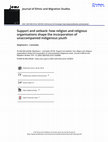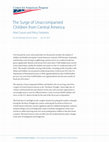Papers by Stephanie L . Canizales
Contemporary Sociology, Dec 27, 2022
Social Forces, Jan 28, 2023
Contexts
Legal violence, or the effects of an intertwining of immigration and criminal law, harms asylum s... more Legal violence, or the effects of an intertwining of immigration and criminal law, harms asylum seekers and immigrants, as well as the U.S. attorneys, social workers, health professionals, and advocates who help them.

International Journal of the Sociology of Language
This paper brings contemporary scholarship on youth migration, Indigeneity, race, and language in... more This paper brings contemporary scholarship on youth migration, Indigeneity, race, and language into conversation with formative work on liminality and rites of passage. Drawing on six years’ worth of participant observation and interviews with L1 Maya (primarily K’iche’) speaking Guatemalan youth workers in Los Angeles, we theorize the transformations that characterize urban immigrant life for Indigenous Latinxs in the contemporary United States as a passage through the liminal state from separation to consummation. We first analyze participants’ language behavior during the separation phase following migration, when youth sought to defend themselves from anti-Indigenous harm and discrimination through discourse practices such as cloaking or denying Maya proficiency, claiming to be Mexican or non-Indigenous Guatemalan, or avoiding speaking Spanish or K’iche’ in public. Participants also employed techniques of bodily concealment that were believed to make them less racially identifia...
Sociology of Race and Ethnicity
University of Arizona Press eBooks, Oct 18, 2022

Journal of Health and Social Behavior
Relying on in-depth interviews and ethnographic data in Los Angeles, California, this study exami... more Relying on in-depth interviews and ethnographic data in Los Angeles, California, this study examines the health experiences of unaccompanied, undocumented Latin American-origin immigrant youth as they come of age as low-wage workers. Findings demonstrate that unaccompanied, undocumented youth undergo cumulative physical and mental health disadvantages in the United States’s secondary labor market and during critical developmental life stages while lacking the parental monitoring and guidance to navigate them. Developing comparisons between their past and present living conditions and between themselves and other youth in Los Angeles—what I refer to as an emergent frame of reference—youth workers come to perceive family disruptions, and especially separation from their parents, as the most salient factor affecting their health. While some youth ultimately resign themselves to short-term attempts to assuage illness, injury, or distress through activities like substance abuse, others p...

Social Problems, 2021
Based on qualitative data drawn from Latino elites, Latino entrepreneurs, and two Latino banks in... more Based on qualitative data drawn from Latino elites, Latino entrepreneurs, and two Latino banks in Los Angeles, we theorize the concept of ethnoracial capitalism, which occurs within racialized groups when group members commodify ethnicity through the sale of culturally-specific goods or when institutions and services are imbued with ethnicity and assumed to form the basis of profitable financial exchanges. We investigate why Latino elites establish Latino-centric banks, and we draw on the perspectives of Latino-elites and middle- and upper-class entrepreneurs to examine whether shared ethnoracial and class resources breed solidarity between Latino elite-owned and -operated banks and the Latino entrepreneurs they target. We find that structural constraints, the state, and class conflict thwarts the possibility of sustaining banking practices rooted in ethnoracial solidarity. Our research provides insights into the fraught intra-ethnic relationships that can occur within ethnoracial c...
Social Forces, 2022
In the originally published version of this manuscript, it was stated that the total number of Gu... more In the originally published version of this manuscript, it was stated that the total number of Guatemalan respondents who originated from the rural highlands and identified as Indigenous was 34 (71 percent). This has been corrected to state the number is 36 (or 75 percent).

Existing research on undocumented youth concentrates on the education and employment of those who... more Existing research on undocumented youth concentrates on the education and employment of those who migrate with their parents and on Dreamers, but a growing number of undocumented youth journey to the US without their parents and are therefore 'unparented' as they come of age. Sociological theories that rely on parents' socioeconomic backgrounds to predict immigrant and non-immigrant youths' socioeconomic outcomes insufficiently explain unparented immigrant youth incorporation, as these youths often do not have access to parents' financial, human, and social capital. Finding Home draws on multiple qualitative methodologies, including four years (nearly 600 hours) of Spanish-language participant observation and 75 in-depth interviews with unparented undocumented young adults aged 18-31 who arrived in the US from Central America and Mexico as minors, some as young as 11 years old. I also completed 15 interviews with attorneys, social workers, activists and community...

Social Forces, 2021
This study investigates the social incorporation of unaccompanied, undocumented Latinx youth work... more This study investigates the social incorporation of unaccompanied, undocumented Latinx youth workers as they come of age in the United States. Based on research with undocumented Central American and Mexican young adults who grew up as unaccompanied minors in Los Angeles, California, the data reveal that the pressures of financial obligations to families in the sending country and their own sobrevivencia (survival) in the United States, along with limited financial and social resource and mobility, produce a social incorporation trajectory shaped by the primacy of work. Work primacy conditions youth’s educational opportunities, community embeddedness, and family relationships and limits unaccompanied, undocumented youth’s ability to establish and maintain social networks with consequences for their social incorporation. The precarious occupations within the secondary labor market that are characterized by long hours, low wages, labor market restrictions, and unsafe and unsanitary wo...

Journal of Ethnic and Migration Studies, 2018
Churches are recognised as pillars of solidarity and support within immigrant communities but rar... more Churches are recognised as pillars of solidarity and support within immigrant communities but rarely in regard to youths' social incorporation. Drawing on 24 months of participant observation of two Catholic churches and in-depth interviews with unaccompanied Guatemalan Maya youth church members in a Los Angeles, California community, this study examines the role of the church and religion in youth's incorporation trajectories. I find that the church and its religious practices provide unaccompanied youth with spaces and resources of incorporation support. Over time, youth also experience financial and socioemotional setback as they become involved in church subunits that are organised by an ethnoracial hierarchy that disparages indigenous Latinos, require financial contributions, and teach reliance on God to change one's circumstances. This study shows that immigrantserving organisations can unwittingly reproduce inequality when they offer individualised solutions to structural marginalisation. Findings also demonstrate that incorporation is as much a socioeconomic process as a socioemotional one, as immigrant youths' mental and emotional health instability can impinge on their social participation.

Over the past few years, and in particular over the past few months, the number of children and f... more Over the past few years, and in particular over the past few months, the number of children and families leaving the Central American countries of El Salvador, Guatemala, and Honduras and arriving in neighboring countries and at our southern border has grown significantly. Already in fiscal year 2014, more than 57,000 children have arrived in the United States, double the number who made it to the U.S. southern border in FY 2013. 1 The number of families arriving at the border, consisting mostly of mothers with infants and toddlers, has increased in similar proportions. In fiscal year 2013, the U.S. Department of Homeland Security, or DHS, apprehended fewer than 10,000 families per year; yet, more than 55,000 families were apprehended in the first nine months of fiscal year 2014 alone. 2 The majority of unaccompanied children and families who are arriving come from a region of Central America known as the "Northern Triangle," where high rates of violence and homicide have prevailed in recent years and economic opportunity is increasingly hard to come by. Officials believe a total of at least 90,000 children will arrive on the U.S.-Mexico border by the end of this fiscal year in September. 3 This brief aims to shed light on this complex situation by putting the numbers of people leaving the Northern Triangle into context; analyzing the broad host of drivers in Central America that have caused a significant uptick in children leaving their countries; and prescribing a series of foreign policy steps to facilitate management of this crisis and also to address the long-term root causes pushing these children to flee their home countries. This brief, however, does not delve into the needed domestic policy changes in the areas of immigration and refugee law.

Ethnic and Racial Studies, 2016
ABSTRACT This paper examines how race, class, and gender intersect to shape professional Latinos’... more ABSTRACT This paper examines how race, class, and gender intersect to shape professional Latinos’ entrepreneurial incorporation, as observed by the conditions that prompt professional Latinos to start a business, including access to capital and experiences with discrimination. In-depth interviews with professional Latino business owners in Los Angeles reveal that individual human capital – via resources and wealth accrued through corporate careers – facilitates entrepreneurial activity. Race, ethnicity, and gender, as intersectional social group identities, combine with class to shape variegated impacts on access to capital and business experiences by gender and target market. Ethnicity is a resource for those serving the coethnic community and is more significant in shaping business ownership experiences for men who target a racially/ethnically diverse clientele, whereas gender and race are more salient for women outside the coethnic community. This study contributes to the ethnic enterprise literature by going beyond ethnicity to demonstrate that multiple dimensions of identity shape professional Latino/as’ entrepreneurial incorporation.
International Multilingual Research Journal

Educational Linguistics
Scholars acknowledge that Indigenous Latinx immigrants' complex process of adapting to life in th... more Scholars acknowledge that Indigenous Latinx immigrants' complex process of adapting to life in the United States, or incorporation, differs from that of their non-Indigenous counterparts. Understanding these differences is especially important as arrivals of Indigenous refugees and asylum seekers from Central America have increased steadily over the past decade and intensified in the last few years. Among them are undocumented, unaccompanied youth, whose migration to the U.S. reached a historic high in 2014 and has persisted into the present (U.S. Customs and Border Protection, 2020). Guatemalans make up the largest segment of the unaccompanied minor migrant population arriving from Central America today. In 2019, Guatemalans made up about 41% of unaccompanied minors apprehended at the U.S.-Mexico border (U.S. Customs and Border Protection, 2020). Many come from rural, often predominantly Maya regions such as the Western Highlands (Stinchcomb & Hershberg, 2014). Their migration is due largely to a legacy of political and gangrelated violence and economic instability in the aftermath of a civil war in which Indigenous Guatemalans were targets of ethnic cleansing. The Maya-speaking Guatemalan youth in this study migrated to the U.S. fleeing this political and economic instability. Though not classified as political refugees or asylum seekers according to the U.S. immigration system, they can be considered refugees insofar as their decisions to migrate were shaped by the intergenerational effects of a genocidal war, including economic devastation and a lack of effective governance leading to what has been termed an ongoing "homicide crisis" in Central America. Today's unaccompanied minors are commonly depicted as searching for family reunification (Donato & Sisk, 2015); yet the long-settled, unaccompanied
Contemporary Sociology: A Journal of Reviews, 2021
health and well-being, including individuals from more ‘‘disconnected’’ groups such as urban yout... more health and well-being, including individuals from more ‘‘disconnected’’ groups such as urban youth. In the book’s conclusion, Cherry mentions attempts by the current administration to weaken environmental laws (bird migratory act, endangered species, pollution, and so on) and also recognizes that the advocacy and tactics of birders and their organizations tend to be largely mainstream, institutional, and reformist. I second her concern. I believe birders could be far more active in ‘‘protecting wildlife through their naturalist gaze.’’ More birders, more birding organizations, and more birding guides must step forward to put their love for these winged wonders into strong action.











Uploads
Papers by Stephanie L . Canizales